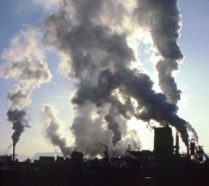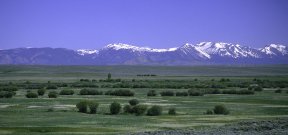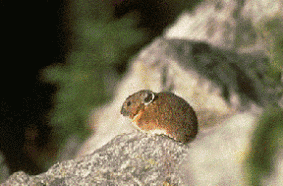A change in climate
Global warming may be wiping out some plants and animals or pushing them into new habitats.
By Emily Sohn
From one day to the next, weather can have a big effect on your life. When it rains, you have to stay indoors or carry an umbrella. When it’s cold, you have to bundle up.
Over the course of hundreds, thousands, and millions of years, weather trends affect life on Earth in more dramatic ways. Ice ages or long droughts, for example, can wipe out certain types of plants and animals. Although many species manage to survive such extreme, long-term climate shifts, their living conditions also change.
 |
|
Does a change in the weather signal global climate change?
|
| National Oceanic and Atmospheric Administration |
There’s lots of evidence of drastic changes in climate occurring in the distant past. Earth today may again be in the midst of such a climate change. In the last 100 years, studies show, global temperatures have risen an average of 0.6 degrees C.
That might not sound so bad. After all, what difference does half a degree make?
A growing number of studies suggest, however, that such an increase could have a big impact on life.
Biologists and ecologists are discovering, often by accident, that climate change is forcing some plants and animals into new habitats. Others are becoming extinct. Sometimes, scientists show up at a site they’ve studied for years, only to discover that the organisms they’ve been tracking are no longer there. What’s more, it now looks like this redistribution of life on Earth is sometimes happening at an alarmingly fast pace.
“These little pieces of information are all warning signs that stuff is going on,” says Erik Beever. He’s a research ecologist with the United States Geological Survey in Corvallis, Ore. “Our world is changing more rapidly than we have observed in the recent past,” he says.
Tree line
One place to look for changes in plant and animal life that may be caused by a climate shift is in the mountains.
As the globe warms up, mountaintops get warmer, too. Trees start growing at higher altitudes than before. The tree line shifts upward.
In the Alps, a mountain range in Europe, records from the last 80 to 100 years show that plants have been working their way upward at a rate of about 4 meters every decade. Researchers from the University of Vienna found this trend in two-thirds of the sites they checked.
 |
|
An Engleman spruce tree.
|
| Rick Wallace, United States Forest Service |
In one recent study in Nevada, Beever discovered that a type of tree called the Engleman spruce had moved its habitat upslope a dramatic 650 feet in just 9 years. “The site at the lowest elevation went from 41 individuals to just six,” he says. At higher elevations, numbers increased.
“When I first saw the results,” Beever says, “I had a really hard time believing it because it’s just too fast.”
Beever’s analysis of the data suggests that global warming is mainly responsible for the shift. Studies in mountain ranges from New Zealand to Spain reveal similar trends.
Global warming
What’s causing today’s increased temperatures?
Many scientists say that human activities, such as burning coal, oil, and other fossil fuels, are largely to blame. These activities release heat-trapping gases, such as carbon dioxide, into the atmosphere. The more these gases accumulate in the atmosphere, the hotter things get on Earth.
 |
|
Burning fossil fuels produces carbon dioxide.
|
| U.S. Environmental Protection Agency |
Some experts remain skeptical. They point out that natural causes may be playing an important role in today’s global temperature increases. The same factors that caused ice ages, extreme heat waves, and massive droughts in the past before human activities were important could still be at work now.
In the case of rising tree lines, they say, trees may still be recovering from an unusually cool period, known as the Little Ice Age, which lasted from the 1300s into the middle of the 1800s. It’s even possible that efforts to put out fires allow plants to move into new habitats.
Mountain islands
Scientists predict that average temperatures may go up another 1.4 to 5.8 degrees in the next 100 years. If it occurs, such a rapid increase wouldn’t give plants and animals much time to adapt to new conditions.
Organisms that live on mountains may face the grimmest future. That’s because mountaintops are, in many ways, like islands. They’re isolated clearings that poke up above the tree line.
 |
|
As ecosystems, mountaintops are, in many ways, like islands.
|
| Virginia Heitman, U.S. Fish and Wildlife Service |
Although it’s too cold for trees to grow at such heights, these alpine environments are ideal habitats for some animals, which have become highly specialized to live there.
“A lot of populations are just little frostings on peaks,” says James Brown. Brown is a population ecologist at the University of New Mexico, who was recently quoted in the journal Science.
Like animals on islands, these mountaintop creatures have no escape if conditions change.
Pick a pika
One of the most direct and dramatic demonstrations of the impact of global warming, Beever says, comes from a furry little creature called the pika.
Hands down, pikas are among the most adorable animals you’ll ever see in the wild. Though related to rabbits, they look like furry little gerbils. “Even as a male, I can say they’re cute,” Beever says. “They’re pretty nifty little guys.”
 |
|
A pika.
|
| National Park Service |
To see pikas, you have to go high up on a mountain because they can’t survive warm weather. In a famous study in the 1970s, a scientist put pikas in cages at low elevations to see what would happen. Many of the animals died, even in the shade. It was just too hot for them.
Their habits make pikas particularly vulnerable to increased temperatures. “They don’t move a lot,” Beever says. “A 1-mile migration for a pika would be a huge, huge, huge deal, and a pretty rare event, as far as we know.” In other words, when conditions change, pikas can’t do much about it.
For more than 10 years, Beever has been surveying pika populations in the mountain states of the U.S. West. By the end of 1999, he had confirmed that seven out of 25 populations that he had originally surveyed were gone. More recently, Beever found that two more populations have disappeared.
Early warning
Not all species are threatened by rising temperatures. Some plants and animals like it hot and dry. Others can move or adapt to get the cold or moisture they need to survive.
Pikas are different. “Pikas are an early warning sign,” Beever. “They are very clearly vulnerable to high temperatures.”
So, the case of the disappearing pikas is reason enough to wake up and take notice, he says. Something in the weather is changing, and the trends look alarming.
But, Beever says, there are things that you can do that may help. Choices you make every day—such as walking instead of going in a car—can add up. By reducing the levels of carbon dioxide and other “greenhouse” gases in the air, we may be able to slow the warming trend.
If nothing else, do it for the pikas. The world could always use a little extra cuteness.
Going Deeper:







